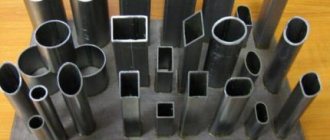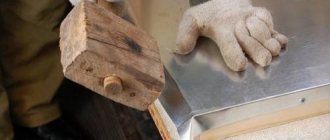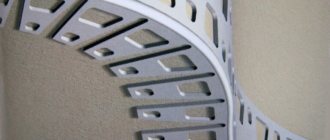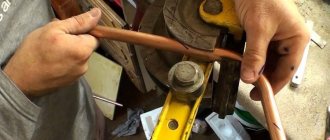- February 21, 2019
- Miscellaneous
- KaplyaDegtya
When during the installation process it becomes necessary to bend the pipe at the required angle, fittings are used - corners specially designed for this. But on difficult turns, several such corners are required, and this does not look aesthetically pleasing. Or maybe it’s just that they are not available at the moment, but installation needs to continue. It is in such cases that the question arises of how to bend a plastic pipe at home.
The manufacturer does not recommend doing this, but you can still bend the pipe. And now we will tell you how.
Types of plastic pipes
Before deciding how to bend a plastic pipe, you need to know that different polymers are used in their manufacture and they all bend completely differently. Plastic pipes are:
- Polyethylene. The most suitable material for creating bends. Even complex curves can be formed from this pliable material. The disadvantage of such pipes is that they are quite fragile and have poor heat resistance. Such a pipe can be bent either cold or hot.
- PVC (polyvinyl chloride). Pipes made of this material are quite fragile, so they can only be bent using a hot method. But that’s not all, since you can only bend a plastic pipe at home if it’s not wide. If you want to change the shape of a pipe with a large diameter, you will need special electromechanical industrial equipment.
- Polypropylene. Pipes made from this material are the strongest, but also the hardest. Polypropylene melts only at very high temperatures, and that is why bending such a pipe at home is quite difficult. A polypropylene pipe can only be given a slight bend using a cold method.
Keep in mind that you can bend a plastic pipe with your own hands, but no matter what material it is made of, it will become thinner on the outside and, on the contrary, thicken on the inside. Carefully check the pipe in the bend area for leaks before installation. Also try to avoid bending the angle too much.
So, how to bend a plastic pipe? There are, as we said above, cold and hot methods. Let's look at them in more detail.
We use a hair dryer
However, if you don’t have a hair dryer at hand, you can use a gas burner. In addition, you will need any object made of hard material that has the angle necessary for bending. This will be the template. It is necessary to clarify that the surface of the template must be perfectly flat. This will help avoid dents and cracks on the surface of the pipe.
The further process of bending at home is as follows:
- The product is heated evenly over the entire fold surface. Do not overdo this procedure and do not bring the plastic too close to the fire. This material burns great! Therefore, take precautions!
- When the surface becomes plastic, the pipe is pressed against the template and bent at the desired angle.
- It is recommended to hold the product until the surface has completely hardened.
- When the heated area has hardened, further installation can begin.
Cold way
This method can only bend a metal, metal-plastic or plastic pipe with thin walls and a small diameter.
You will need:
- Purchase a special spring that will match the internal diameter of the pipe.
- When it is not possible to purchase a spring, it can be replaced with sand by pouring it inside the pipe and plugging it on both sides with wooden or plastic plugs.
- Make a template from chipboard or cardboard that will correspond to the bend angle you require.
Further, everything will depend on the diameter of the pipe, since it is possible to bend a plastic pipe of small diameter without the use of special clamps, and for larger diameters or made of harder materials, or having thicker walls, special electromechanical (pipes over 6 cm) or hydraulic ( pipes up to 6 cm) machines.
Why make a bend?
Many people do not know why to make pipelines of complex shapes. In apartments of multi-storey buildings, a central riser runs through all floors. There is no need to bend the tubes to connect to it. It is enough to select tees, cut into the riser, and divert the water supply circuits from it.
If we are talking about laying a pipeline in a private house and the system is being manufactured from scratch, it is impossible to do without turning the pipes. Tubes are routed from the heating boiler to different rooms. You can avoid making turns and use corner couplings, but this will reduce the reliability of the system. Another area where it is impossible to do without bending pipes is the production of “warm floor” systems.
How to bend a plastic sewer pipe using a spring?
- Place the spring inside the pipe. In cases where the internal diameter of the pipe is slightly larger than the diameter of the spring, the latter can be fixed to the pipe with clamps.
- Slowly bend the pipe, gradually achieving the required bend radius. Keep in mind that when bent, polyethylene pipes gradually take on their previous shape, so when bending, they must initially be given a larger radius.
This method is, in principle, universal, since it is also possible to bend a plastic water pipe in this way. In general, the purpose of the pipe does not play any role - when bending, only the type of polymer used in its manufacture is important.
Properties of plastic pipeline
All plastic pipes can be divided according to the material they are made of: they are made from polymers, polyethylene, polyvinyl chloride. The listed materials have good hygienic characteristics, so they are excellently used for arranging a heating network, as well as for organizing water supply in an apartment.
It’s not always possible to bend the material yourself, so you have to use popular methods
To bend a plastic pipe yourself, you need to learn more about its properties:
- Ring stiffness. The high rigidity of PVC allows it to withstand atmospheric pressure of 120 atmospheres.
- Heat resistance. Plastic is resistant to heat, so it is used for arranging water supply systems with hot and cold water, as well as for organizing heating pipelines. When heated, plastic only expands by 5%.
- Low resistance to frost. Due to their low resistance to frost, the materials cannot withstand temperatures below -15 degrees, and therefore require additional thermal insulation.
- High light transmittance. The PVC pipe, painted in various colors, is UV resistant.
PVC products for pipeline installation are available in various diameters
When heated, the plastic pipe can be carefully bent because it has good elastic properties. Products made from bendable polyvinyl chloride during production can initially be wound into rings - in this form they go on sale.
Hot way
Before bending a plastic pipe using this method, you also need to prepare a special spring (pipe bender). In addition, you will need:
- Construction hair dryer with multi-stage temperature control.
- Forming machine. You can make it yourself from a piece of chipboard by attaching clamps to it in the places of planned bends.
- Make blanks from the block that correspond to the bend angle of the pipe.
Safety precautions at work
Although many manufacturers of polypropylene products do not recommend bending them, since their strength is impaired, sometimes it is necessary to do this, since otherwise it is impossible to lay communications differently.
When carrying out work with your own hands, you should follow certain safety rules:
- All work should be performed only with heat-resistant gloves, since the heating temperature is 140-150 ᵒC, and it is easy to get burns.
- If heating is carried out with an industrial hair dryer, it should be firmly secured to some base so that it does not fall during the work.
- It is better to do the work together. This will make it easier to give the product the desired shape.
Some “craftsmen” advise using gas burners if you don’t have a hair dryer. But this is unacceptable, since an open flame can damage the pipe, and an accidentally dropped cylinder with a working burner can lead to a fire.
It is best to bend such pipes to a certain radius using a pipe bender.
If sand is poured inside and the ends are plugged with plugs, it is recommended to make a small hole in one of the plugs to allow the heated air to escape. Although the pressure inside will be small, it is nevertheless better to do this.
Hot bending instructions
You need to do the following:
- Prepare the pipe by inserting a spring into it. You can, just like with the cold method, pour sand inside it, but at high temperatures it can melt into the inner walls of the pipe, which is why the pipe will become rough at the bend. All the debris will linger there and dirt will constantly stick.
- The prepared pipe must be secured to the machine using clamps. You can also use a silicone molding sleeve.
- In the places of the planned bend, place templates of bars on top of the pipe, along which the pipe will be bent.
- Heat the pipe with a hairdryer while simultaneously creating a bend according to the template. The melting point of PVC is 130 degrees, polypropylene is 150. The pipe must be bent very smoothly and slowly, otherwise a sagging or fold will form on the inside of the bend.
- After all the bends are made, the pipe is left on the clamps in this position until it cools completely.
It is also necessary to check the correctness of the bend after the pipe has completely cooled.
Features of low pressure polyethylene pipes
Pipes made of low-density polyethylene (HDPE or HDPE according to the international classification) are increasingly replacing metal pipes from use in construction.
Bend angle
45 degree bend
The sensitivity of the material to heat, its elasticity and lightness make it possible to create blanks from HDPE pipes in order to change the direction of the laid pipeline and go around obstacles.
It should be taken into account that the bending angle should not exceed 90°.
Angles of 30, 45, 60, 90 degrees are considered standard.
Melting temperature
When molding polyethylene pipe products, it is necessary to take into account the temperature characteristics of the material. Its softening begins at a temperature of +80Сo, and melting occurs from +130Со to +137С о. It is at this temperature that HDPE pipes are produced.
How to check the result of your work
- First, you need to visually evaluate the work - inspect the pipe for chips, sagging, cracks, folds and any other defects. A well-bent pipe has no external signs of bending.
- Secondly, before bending the plastic pipe, you made a template along the bend radius. It is necessary to check whether the obtained result matches the desired one.
- Third, pour water inside the pipe and check its tightness. But you should know that even a sealed pipe at the bend will gradually become thinner, especially with high water pressure. Microcracks will appear in it, and such a pipe will have to be replaced.
Basic rules for working with plastic
To bend a polypropylene pipe without violating its integrity, you must take into account the rules for working with plastic:
- Bending technology resembles the process of working with metal products. To change the shape of a plastic part, you need to heat it. For this purpose, you cannot use blowtorches or burners. A hair dryer with a temperature control is suitable.
- The workplace must be cleared of any flammable materials and liquids.
- Wear gloves made of fire-resistant material.
- When bending, perform movements smoothly.
- Control the bend radius. The maximum value is the tube diameter multiplied by 8.
We must not forget that plastic is easily deformed from high temperatures. Therefore, when bending pipes, it is necessary to control the temperature. The optimal temperature is 170 degrees.
Which pipe should not be used?
If, after cooling, you see that strong folds have appeared on the inside of the bend or, conversely, that the outside is very thin, then, unfortunately, such a pipe cannot be used. All kinds of dirt will constantly accumulate in the folds, and the pipe will become constantly clogged. And a thinned inner side will lead to rapid wear.
Also, if after the pipe has cooled down you see that you were unable to achieve the desired bend, then you need to either throw it away or use it in a place where this radius is suitable, since it will not be possible to bend the plastic pipe again. That is why it is advised to make preliminary templates and bend the pipe strictly according to them.
Conditions for bending PVC pipes
Plastic bends well if it is exposed to certain temperatures. It is important to meet several conditions for bending:
- heating the area to 75 degrees in the place where the bend will be made;
- exposure to the element using vaporous substances.
In order not to buy a lot of unnecessary fittings that require care during installation, craftsmen often use various bending techniques. When working with heated air that will affect plastic, you should be careful: you can not only completely burn the heating area, but also burn your hands. In this case, it is important to carry out manipulations carefully and gradually.
READ ALSO: Marking of polypropylene pipes for heating - read the data correctly
Polypropylene and polyvinyl chloride are easy to bend
It can be difficult to achieve the perfect bend, so before starting work, it is recommended to carefully consider all future turns of the pipeline. It’s worth practicing bending the product in a small segment in advance.
To bend or not to bend: is it possible and how best to form a bend on a sewer pipe
Even with precise planning of the route for laying an external or internal sewer pipeline, it is not always possible to avoid sharp turns and bends. Most often, you have to decide how to bend a sewer pipe when installing it in hard-to-reach places: in niches and under plumbing siphons, when coming out of a wall or ceiling, or the need to get around a ledge or corner. There are two options for solving the problem:
- Instructions: bending pipe step by step
- Flexible sewer pipes: application
Connections and bends for thick-walled sewer pipes
- Use special ready-made bends - fittings and adapters, installing them at the point of change of direction with a special sealant or seal.
An example of arranging a non-standard pipeline in difficult conditions.
Clearly, if there is the slightest opportunity to avoid bending sewer pipes, it is worth taking advantage of it. The variety of factory products allows you to find the optimal solution even in difficult situations. If it is impossible to install a rigid pipeline, it is better to install a corrugated pipe with the possibility of regular replacement. It is strictly not recommended to bend plastic products of large diameter, especially if you plan to install a branch in a screed or under a plasterboard panel - it will be difficult to find and eliminate the leak. It is impossible to repair or seal a bent plastic pipe; the entire section will have to be replaced. If you cannot do without bending, then it is better to entrust the process of bending and installation to a specialist.
Source
Some important tips
In order for pipe bending work to be successful, you need to take into account several important recommendations:
- If you use sand as a stabilizer and shock absorber, you should know that it must be filled in until the internal lumen of the pipe is completely filled along its entire length. But do not stuff it too thickly.
- It is better to use metal plugs for the edges of the element. Especially if we bend a steel element. Because when the pipe is heated, plastic can melt and adhere to the metal. This will not particularly harm the pipe, but roughness may remain in its internal lumen, which can subsequently lead to the accumulation of debris in these places.
- Heat the pipe with a hairdryer or burner slowly, achieving a uniform temperature.
- The pipe should not be bent with a sharp jerk, but with smooth progressive pressure, so as not to damage the pipe material.
Recommended precautions
When bending a PP pipe, the polypropylene is stretched on the outside and compressed on the inside. If mechanical action is performed incorrectly, the product becomes deformed.
Defects on parts also appear when exposed to high temperatures, which are used to soften the material of pipeline elements. Therefore, bending must be done while observing the following precautions:
- Do not overheat the PP product. At temperatures above 150°C, ductility increases significantly. If heating is continued, the part will easily become wrinkled and may even melt.
- Do not expose to high temperatures for a long time. You need to heat it until it becomes pliable. Prolonged heating will lead to a change in the properties of polypropylene.
- The pipe part must be heated evenly from all sides.
- Do not reduce the permissible bend radius. This parameter is determined depending on the outer diameter of the tubular product. The value must not be less than 8D straight element.
The minimum permissible bending radius of popular standard sizes of PP pipes is indicated in the table below.
Bending at home
Technologies were described above, using which you can easily bend polypropylene pipes. In order not to compromise the integrity of parts during the work process, it is necessary to take into account some factors:
- Polypropylene begins to melt at a temperature of 140 degrees. Heating above this temperature range causes the plastic to spread and destroy its structure. When heating, do not raise the temperature above 150 degrees.
- It is important to correctly calculate the heating time. When the plastic becomes pliable, you need to turn off the heating device. If heating is continued, the technical characteristics of the material will quickly decrease.
- It is necessary to constantly rotate the pipe while heating so that its sides are heated evenly. Overheated areas will become weak areas during operation.
It is better to practice on unnecessary tubes in order to master the bending process.
Bending on a molding machine
A polypropylene pipe can be bent with high quality using a special molding machine.
This method allows you to complete the task with minimal effort and achieve great accuracy in the angle and bend radius.
Before starting work, it is necessary to make a frame with the required radius to shape the product. For its manufacture, you can use fiberboard. When creating a frame, you need to carefully sand all surface defects that could damage the plastic (jags, sharp corners, etc.) with sandpaper. After this, a special silicone shell is formed on a molding machine. Its diameter should be slightly larger compared to the diameter of the pipe.
The plastic pipe is placed in a shell secured to a prepared fiberboard frame. The entire structure must be placed on the molding machine. Then the product is heated. In this case, the plastic gradually becomes flexible, and the pipe evenly lies on the frame, taking the desired shape. The product is left to cool for 10 minutes, after which it is removed and removed from the shell. After this, the pipe must be put aside until it cools completely. When it has completely cooled, it can be used to install the pipeline.











